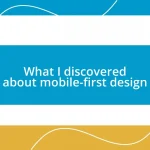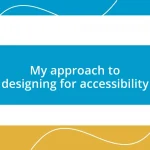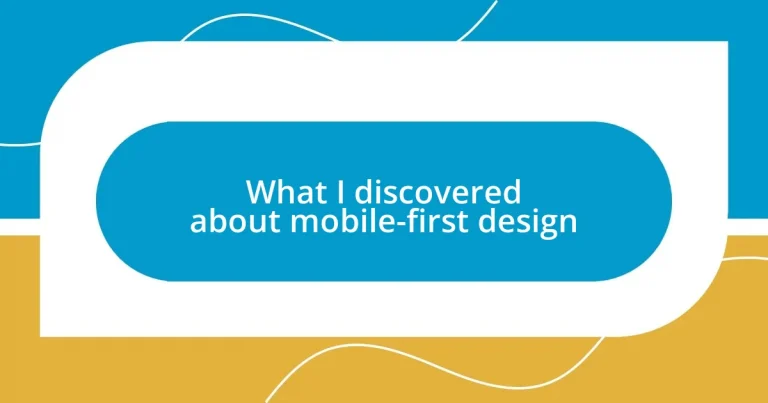Key takeaways:
- Mobile-first design prioritizes user experience on smaller screens, emphasizing the need for simplicity and essential features.
- This approach enhances user satisfaction and engagement by optimizing performance and content hierarchy for mobile devices.
- Real-world case studies demonstrate significant improvements in conversion rates and user engagement through effective mobile-first strategies.
- Utilizing tools like responsive design frameworks and prototyping software is crucial for successful mobile-first development and testing across devices.
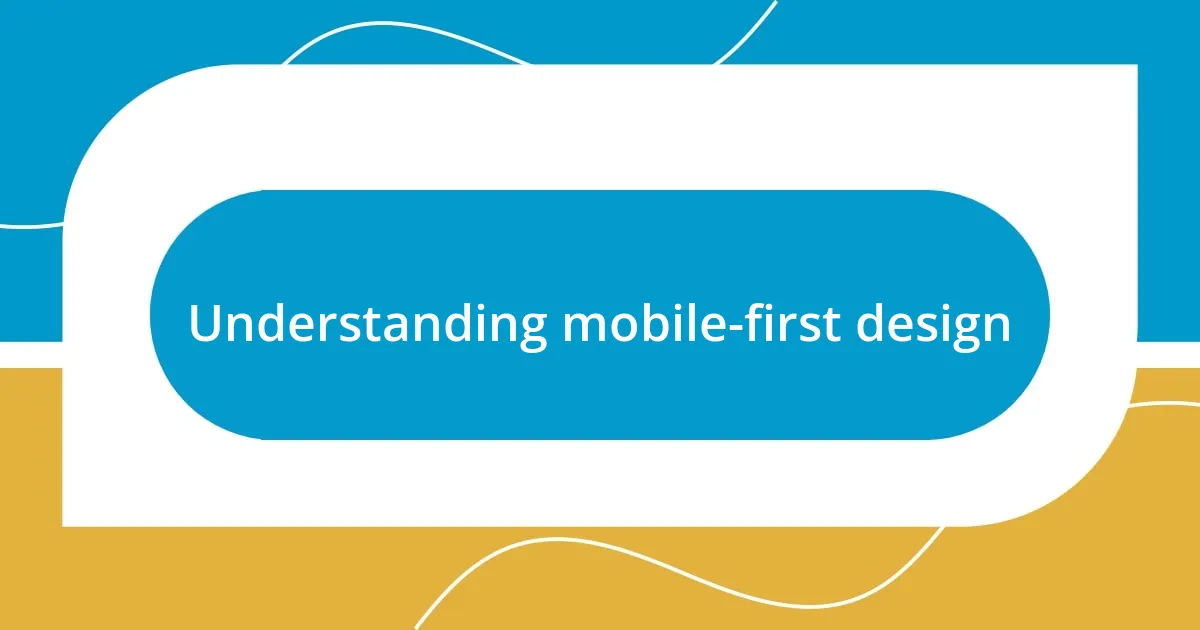
Understanding mobile-first design
Mobile-first design is fundamentally about prioritizing the user experience on smaller screens before addressing larger displays. I remember the first time I realized just how much my own browsing habits had changed—I was on the subway, scrolling through a website that was clearly built for desktop, and it felt clunky and frustrating. Have you ever experienced that? It’s incredible how our environments shape our interaction with technology.
When I delve into mobile-first design, I think about the sheer number of users accessing content primarily through their phones. It’s not just a trend; it’s a shift in how we consume information daily. I often ask myself, “How can I make navigation effortless on a tiny screen?” Stripping down features and focusing on essential elements ensures that users don’t get lost in a sea of content.
Ultimately, mobile-first design isn’t just a strategy; it’s a mindset. Shifting my perspective changed how I approach web development entirely. It’s a continuous journey of learning to adapt interfaces that truly resonate with users, and I find that figuring out how to balance aesthetics with functionality is exciting. Have you tried that delicate dance? It’s one that can lead to remarkable user satisfaction when done right!
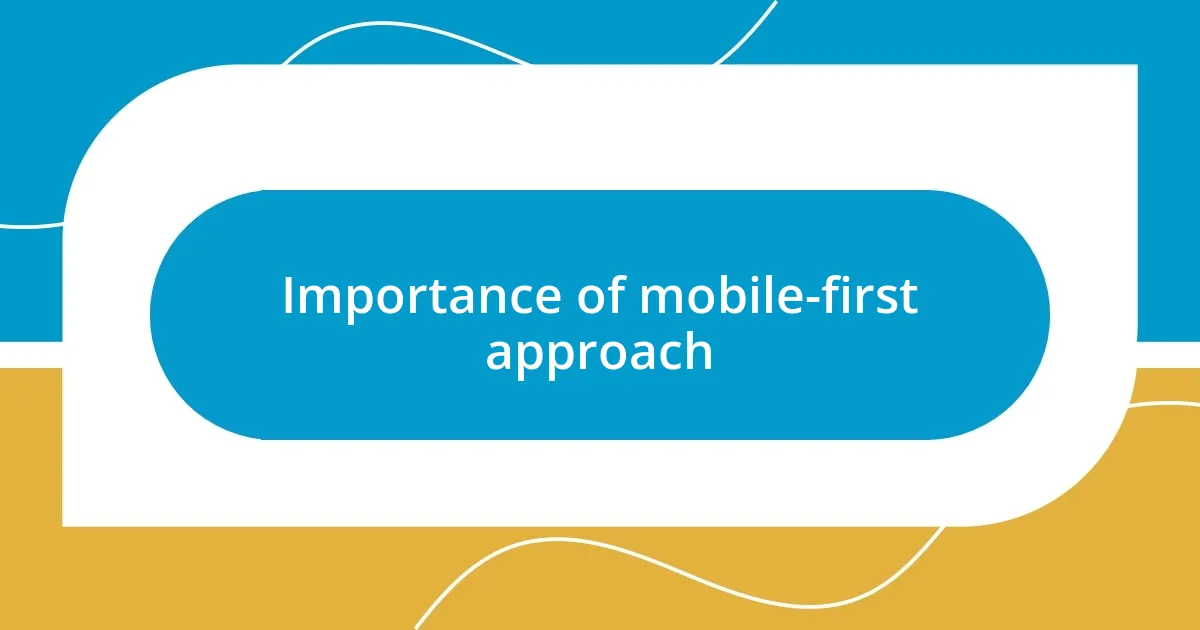
Importance of mobile-first approach
The mobile-first approach is crucial in today’s digital landscape because it directly reflects the behavior of users. I’ve noticed in my own experience that people often reach for their phones first, whether they’re shopping, searching for information, or even browsing social media. This shift in preference means that if a website is not designed optimally for mobile devices, it risks losing potential users and, in turn, business.
Furthermore, adopting a mobile-first strategy encourages designers and developers to prioritize essential features. I recall a project where we stripped down unnecessary elements to enhance loading time and user engagement. The feedback was overwhelmingly positive; users appreciated the streamlined experience that didn’t overwhelm them with options. This process not only leads to better user satisfaction but also creates a more effective and engaging website overall.
Lastly, the mobile-first approach has significant implications for SEO. As I’ve learned, search engines prioritize mobile-friendly sites since they cater to the modern user’s needs. When I optimized a site primarily for mobile, its visibility improved dramatically. This change made me realize that focusing on mobile first isn’t just about aesthetics; it’s about creating a viable long-term strategy for growth and reach in a highly competitive landscape.
| Traditional Design | Mobile-First Design |
|---|---|
| Desktop-oriented experience | User-centric experience |
| Includes all elements at once | Focuses on essential features first |
| Longer loading times | Optimized for faster performance |
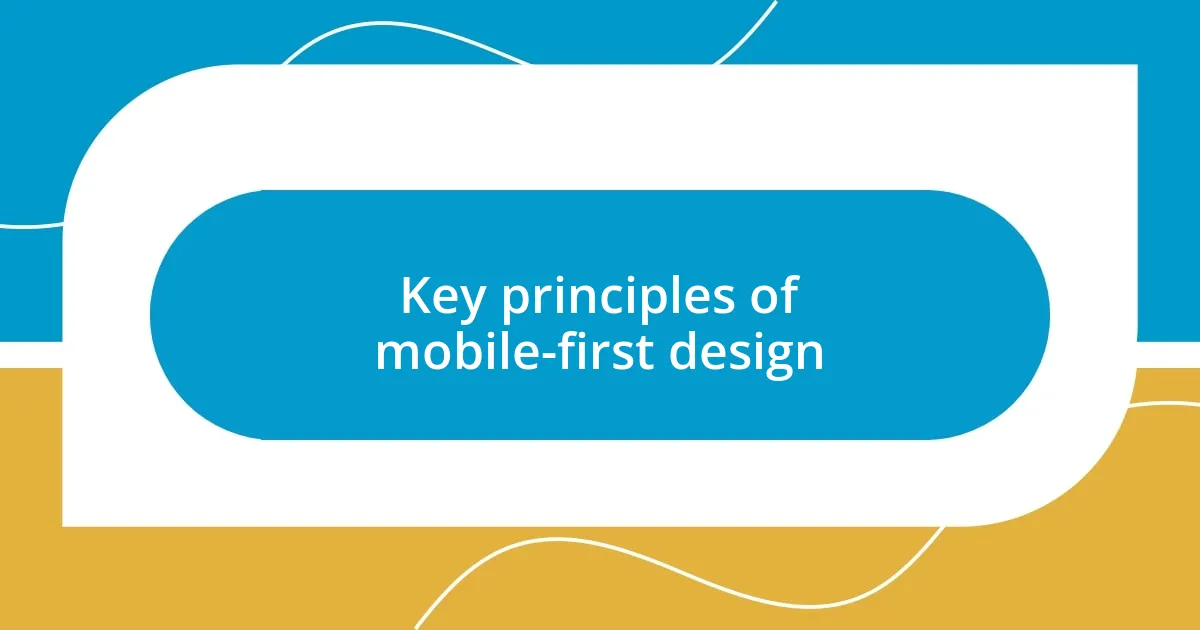
Key principles of mobile-first design
Mobile-first design revolves around a few essential principles that guide us toward creating effective and enjoyable user experiences. For me, one of the most critical aspects is simplifying the interface. I remember working on a travel app where I had to prioritize features for our users on the go. By focusing on the most essential functions—like booking and itinerary viewing—we could ensure that the app felt intuitive and responsive. This not only reduced the cognitive load but also led to higher user retention.
Here’s a quick breakdown of key principles:
- Simplicity is key: Keep the design minimal by showcasing only essential features.
- Responsive layouts: Use flexible grids to adjust the design seamlessly across different screen sizes.
- Touch-friendly elements: Ensure buttons and links are easy to tap, avoiding frustration in navigating.
- Fast load times: Optimize images and resources to ensure quick access to content.
- Prioritize content: Deliver the most important information first, guiding the user through their journey effectively.
In my experience, applying these principles meticulously can transform how users interact with a website or app. It’s about making every element count, something I learned early on during a redesign for a client-focused platform. When we followed these principles, we saw a tangible increase in user satisfaction and engagement metrics, which only reinforced my passion for mobile-first design.
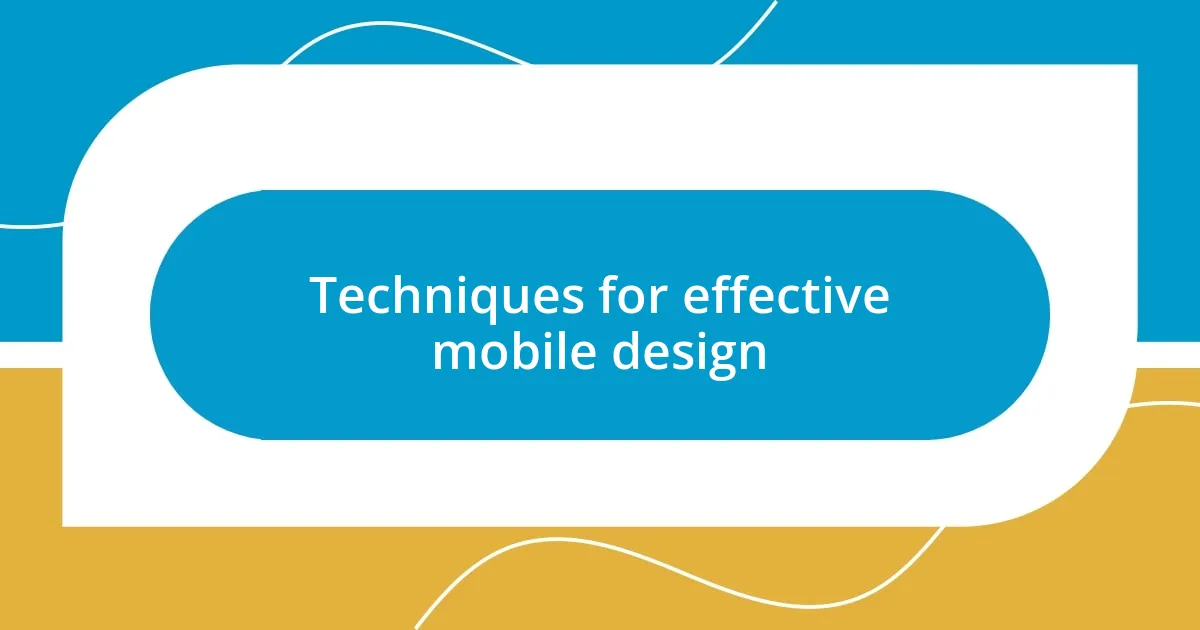
Techniques for effective mobile design
When diving into mobile design techniques, I’ve found that prioritizing touch-friendly elements makes a significant difference. Imagine trying to book a flight on a cramped mobile screen, only to struggle with tiny buttons—that’s frustrating, right? During a recent redesign for an e-commerce site, we enlarged buttons and increased spacing, which led to a more enjoyable shopping experience. The feedback was immediate; users felt less stressed and more inclined to complete their purchases.
Another technique that I often rely on is optimizing images and resources for faster loading times. I remember a project where we implemented lazy loading, a practice that delays the loading of resources until they’re needed. This not only improved performance but made users feel like they weren’t waiting around, which is crucial in our fast-paced world—doesn’t every second count when you’re on the go? Since making this change, I’ve seen the bounce rate drop significantly, reaffirming my belief that speed significantly enhances user satisfaction.
Lastly, a strong emphasis on content hierarchy is essential for effective mobile design. I’ve discovered through various projects that presenting the most critical information first can guide users effortlessly through their journey. During one project for a news app, we arranged articles in a way that prioritized trending topics. This simple shift transformed the user experience; readers could quickly get the news they cared about, which naturally led to longer sessions. Isn’t it amazing how a little thoughtful organization can foster deeper engagement?
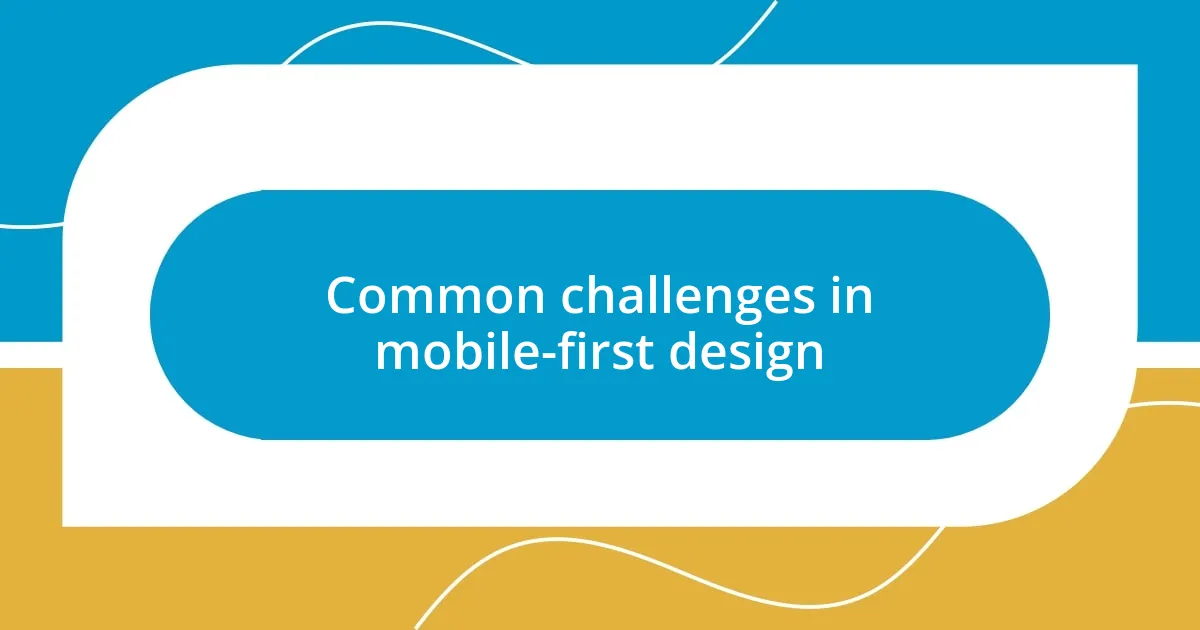
Common challenges in mobile-first design
Mobile-first design does come with its fair share of challenges. One common hurdle I’ve faced is the limitation of screen real estate. I remember working on a health tracking app where fitting key features into a small screen felt like trying to stuff a suitcase at the end of a trip—there’s always that last item that just won’t fit! This experience taught me that careful prioritization and thoughtful organization are crucial. Sometimes, it’s about making tough decisions regarding which features to highlight without overwhelming the user.
Another challenge is maintaining performance while still delivering rich content. I vividly recall a project for a restaurant app that included high-resolution images of mouth-watering dishes. While aesthetically pleasing, these images bogged down the app’s performance. We experimented with compression tools and optimized formats, but it was a delicate balancing act. The takeaway? Sometimes less really is more, and optimizing for speed can enhance user experiences in ways that heavy visuals cannot—have you ever felt frustrated waiting for a page to load?
Lastly, the frequent evolution of mobile devices can complicate design efforts. As screen sizes and capabilities change, I’ve noticed that what works perfectly on one device might fall short on another. During a campaign for a social media platform, I realized that our design didn’t translate well across various iOS and Android devices. It was an eye-opener for me about the importance of thorough testing on multiple devices and platforms. This led me to advocate for a more iterative design approach—after all, adapting to change is just as important as the initial design itself, wouldn’t you agree?
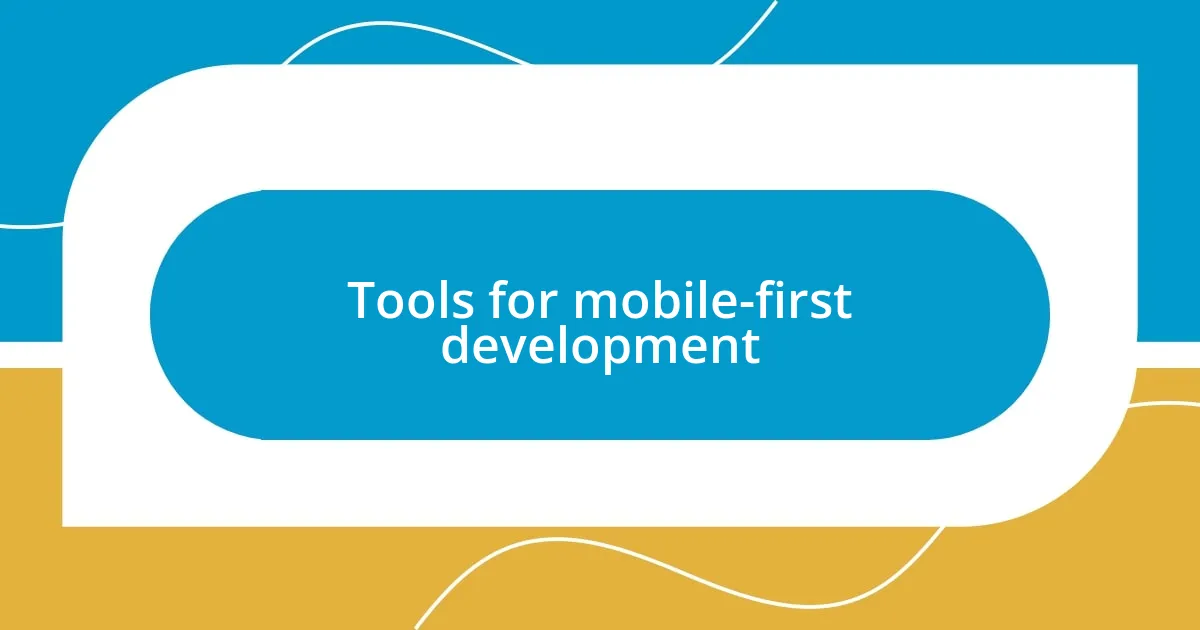
Tools for mobile-first development
When it comes to tools for mobile-first development, my go-to has always been responsive design frameworks like Bootstrap or Foundation. I vividly remember diving into a project where we had to ensure compatibility across devices. I chose Bootstrap, and what a revelation that was! The grid system allowed for a fluid layout that adjusted seamlessly, making the design process not just easier, but a lot more enjoyable. Have you ever felt the thrill when everything clicks into place?
Another great tool I’ve found invaluable is Chrome DevTools. Recently, while revising a mobile app, I used the device toolbar feature extensively to switch between different screen sizes. It felt like I was stepping into the shoes of my users! The ability to simulate various mobile environments helped me catch issues early, saving time and headaches later. I can’t stress enough how empowering it is to visualize the app’s performance in real-time. Isn’t it incredible how technology can simplify complex tasks?
Lastly, I can’t overlook the importance of prototyping tools like Figma and Adobe XD. When I was tasked with redesigning a travel booking site, these tools helped me create interactive wireframes that felt almost like the finished product. Being able to share these prototypes with stakeholders for feedback was a game-changer. It transformed our collaboration and boosted enthusiasm around the project. Don’t you find that getting everyone on the same page early sparks creativity and innovation?
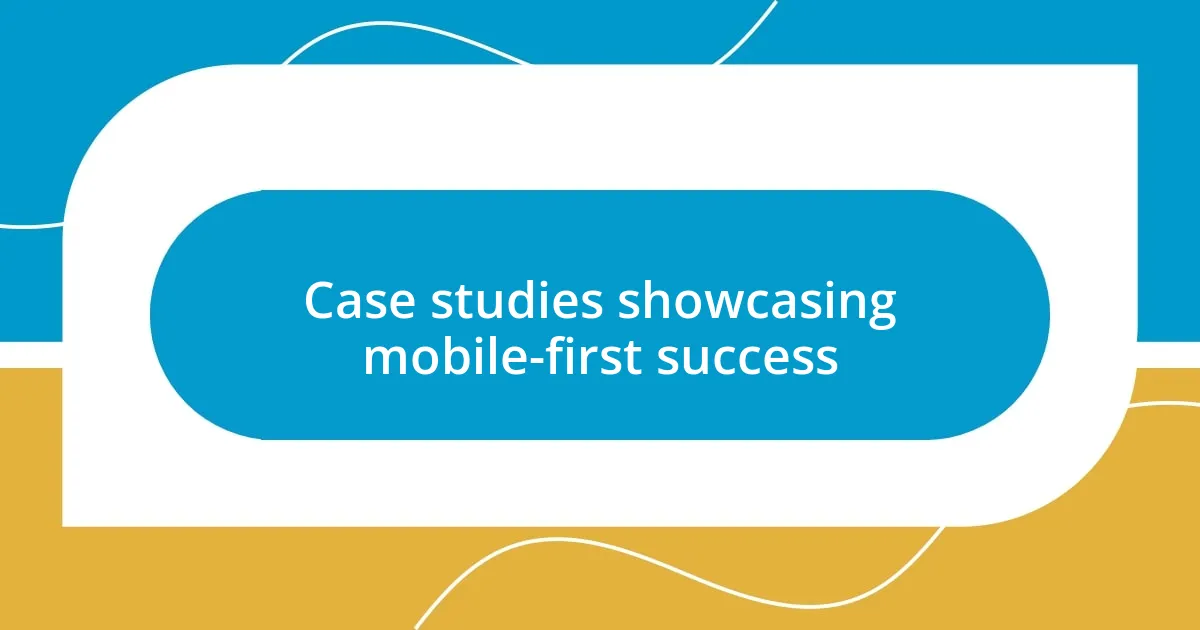
Case studies showcasing mobile-first success
One compelling case study that stands out is the transformation of a leading e-commerce platform that prioritized a mobile-first approach. Initially, their mobile conversion rates were dismal—hovering below 10%. By streamlining the shopping experience for mobile users, simplifying navigation, and optimizing the checkout process, they skyrocketed their mobile conversion to over 30% within six months. I often reflect on how the right changes can turn frustration into ease, and their success serves as a powerful reminder of that.
Another enlightening example comes from a nonprofit organization that revamped its donation platform with a mobile-first mindset. Before the redesign, many potential donors abandoned the process due to confusion and a complicated layout on mobile devices. By implementing a straightforward, single-page donation form and prioritizing mobile responsiveness, they not only increased online donations by 50% but also improved user engagement significantly. It’s incredibly gratifying to see how thoughtful design can directly impact meaningful causes—don’t you think it’s inspiring when technology helps bridge gaps in giving?
I remember closely following the redesign of a popular travel app that had been struggling to attract users. They adopted a mobile-first strategy that emphasized user-generated content and localized recommendations. The changes led to a 40% increase in active users and heightened community engagement. It’s remarkable how prioritizing the mobile experience can not only enhance usability but also foster a stronger connection among users. Have you experienced a similar journey where design has positively influenced user behavior?


